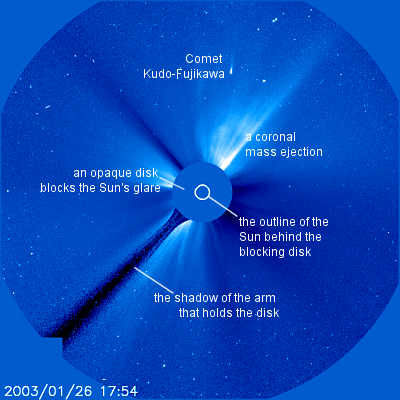| |
What
is a Coronagraph?
-an artificial solar eclipse-
A coronagraph is a telescope that can see
things very close to the Sun. It uses a disk to block the Sun's
bright surface, revealing the faint solar corona,
stars, planets and sungrazing comets. In other words, a coronagraph
produces an artificial solar eclipse.
The Solar and Heliospheric Observatory (SOHO)
has two coronagraphs onboard, one with a 3-degree field of view
(the "C2" coronagraph) and another with a 16-degree
field of view (the "C3" coronagraph). For comparison,
the Sun itself is 0.5 degrees across. C2 coronagraph images are
usually colored red; C3 coronagraph images are blue:

Related links:
- the latest
coronagraph images from SOHO
- A Christmas Star for SOHO --
(Science@NASA) On May 17th, 2000, SOHO coronagraphs recorded
an impressive conjunction of Venus and Jupiter that happened
near the Sun
- Some Comets Like it Hot -- (Science@NASA)
Using SOHO coronagraphs, amateur astronomers are discovering
pieces of a giant comet that broke apart in antiquity as the
fragments zoom perilously close to the Sun.
- Solar Smoke Rings -- (Science@NASA)
The Sun puts on a dynamic show with a series of swirling coronal
mass ejections
- Kamikaze Comets -- (Science@NASA)
Many sungrazing comets discovered by SOHO appear to have come
from the breakup of a single gigantic comet more than 2000
years ago.
Back to spaceweather.com
|
|